Imperial College London (ICL)
Derniers ajouts au Imperial College London (ICL). Vous recherchez des notes d'étude à Imperial College London (ICL)? Nous avons de nombreuses notes de cours, guides d'étude et notes d'étude disponibles pour les cours de votre institution.
-
456
-
1
-
31
Études @ Imperial College London (ICL)
Notes disponibles pour les études suivantes sur Imperial College London (ICL)
-
A Level 1
-
Ashmole Academy 1
-
Biochemistry 4
-
Biology 1
-
Biomedical Engineering 4
-
BS phyics 1
-
Bs physics 1
-
Imperial College London 70
-
Mechanical Engineering 2
-
MSc Climate Change, Management and Finance 3
-
Physics 1
Dernières notes et résumés Imperial College London (ICL)
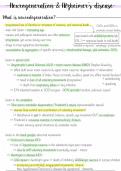
Lecture notes from Imperial College London, Medical Biosciences BSc, 2nd year, Neuroscience (NEU) module. One of the great health challenges of our times is to cope with the increasingly prevalent age-related disorders as life expectancy rises globally. Neurodegenerative diseases are among the most devastating of those, leading to relentless impairment of the nervous system’s function, affecting the ability to lead independent lives, and eventually death. Despite large research efforts in t...
- Package deal
- Notes de cours
- • 8 pages's •
-
Imperial College London•Neuroscience
-
Neuroscience module Imperial College London• Parlisaribau
Aperçu 2 sur 8 pages
Lecture notes from Imperial College London, Medical Biosciences BSc, 2nd year, Neuroscience (NEU) module. One of the great health challenges of our times is to cope with the increasingly prevalent age-related disorders as life expectancy rises globally. Neurodegenerative diseases are among the most devastating of those, leading to relentless impairment of the nervous system’s function, affecting the ability to lead independent lives, and eventually death. Despite large research efforts in t...
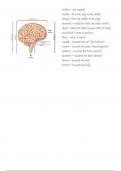
Lecture notes from Imperial College London, Medical Biosciences BSc, 2nd year, Neuroscience (NEU) module. Vocabulary neurology + list of classical syndromes and damages.
- Package deal
- Notes de cours
- • 2 pages's •
-
Imperial College London•Neuroscience
-
Neuroscience module Imperial College London• Parlisaribau
Aperçu 1 sur 2 pages
Lecture notes from Imperial College London, Medical Biosciences BSc, 2nd year, Neuroscience (NEU) module. Vocabulary neurology + list of classical syndromes and damages.
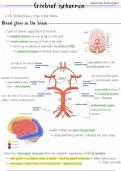
Lecture notes from Imperial College London, Medical Biosciences BSc, 2nd year, Neuroscience (NEU) module. Cerebral ischaemia: an interruption in the blood supply causing disruption of brain function, usually leading to a permanent sensory, motor or cognitive deficit. It is calculated that in England, one in six people will have a stroke in their lifetime. learning outcomes: LO1: Describe the main features of brain blood circulation. LO2: Distinguish between different types of cerebral ...
- Package deal
- Notes de cours
- • 7 pages's •
-
Imperial College London•Neuroscience
-
Neuroscience module Imperial College London• Parlisaribau
Aperçu 2 sur 7 pages
Lecture notes from Imperial College London, Medical Biosciences BSc, 2nd year, Neuroscience (NEU) module. Cerebral ischaemia: an interruption in the blood supply causing disruption of brain function, usually leading to a permanent sensory, motor or cognitive deficit. It is calculated that in England, one in six people will have a stroke in their lifetime. learning outcomes: LO1: Describe the main features of brain blood circulation. LO2: Distinguish between different types of cerebral ...
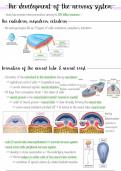
Lecture notes from Imperial College London, Medical Biosciences BSc, 2nd year, Neuroscience (NEU) module. Look at the development of the nervous system, with a focus on understanding the structural organisation of the brain and how new neurons and synaptic connections are formed. Learning objectives: LO1: Recognise which embryonic layer gives rise to the nervous system and summarise the formation of the neural tube and neural crest. LO2: Outline how the forebrain, midbrain and hindbra...
- Package deal
- Notes de cours
- • 9 pages's •
-
Imperial College London•Neuroscience
-
Neuroscience module Imperial College London• Parlisaribau
Aperçu 2 sur 9 pages
Lecture notes from Imperial College London, Medical Biosciences BSc, 2nd year, Neuroscience (NEU) module. Look at the development of the nervous system, with a focus on understanding the structural organisation of the brain and how new neurons and synaptic connections are formed. Learning objectives: LO1: Recognise which embryonic layer gives rise to the nervous system and summarise the formation of the neural tube and neural crest. LO2: Outline how the forebrain, midbrain and hindbra...
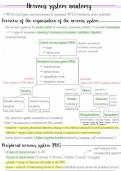
Lecture notes from Imperial College London, Medical Biosciences BSc, 2nd year, Neuroscience (NEU) module. learning objectives: LO1: Recall the gross organisation of the human central and peripheral nervous systems LO2: Illustrate the structure and functions of the spinal and cranial nerves LO3: Identify the main CNS structures and summarise their functions: spinal cord, brainstem, diencephalon, basal ganglia, cerebral cortex and cerebellum. LO4: Explain the structure and function of: c...
- Package deal
- Notes de cours
- • 11 pages's •
-
Imperial College London•Neuroscience
-
Neuroscience module Imperial College London• Parlisaribau
Aperçu 2 sur 11 pages
Lecture notes from Imperial College London, Medical Biosciences BSc, 2nd year, Neuroscience (NEU) module. learning objectives: LO1: Recall the gross organisation of the human central and peripheral nervous systems LO2: Illustrate the structure and functions of the spinal and cranial nerves LO3: Identify the main CNS structures and summarise their functions: spinal cord, brainstem, diencephalon, basal ganglia, cerebral cortex and cerebellum. LO4: Explain the structure and function of: c...
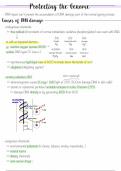
Lecture notes from Imperial College London, Medical Biosciences BSc, 2nd year, genetics and genomics (GEN) module. Our DNA is under constant threat of being damaged by exogenous and endogenous insults. We have some mechanisms that provide protection from these insults, but there are limits to what they can achieve. In these notes, we consider how DNA damage arises, how it can be avoided, what it actually looks like, and how it is repaired. We also see how mutations in DNA repair genes are ass...
- Notes de cours
- • 8 pages's •
-
Imperial College London•Genetics
Aperçu 2 sur 8 pages
Lecture notes from Imperial College London, Medical Biosciences BSc, 2nd year, genetics and genomics (GEN) module. Our DNA is under constant threat of being damaged by exogenous and endogenous insults. We have some mechanisms that provide protection from these insults, but there are limits to what they can achieve. In these notes, we consider how DNA damage arises, how it can be avoided, what it actually looks like, and how it is repaired. We also see how mutations in DNA repair genes are ass...
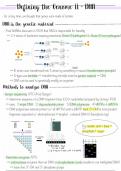
Lecture notes from Imperial College London, Medical Biosciences BSc, 2nd year, genetics and genomics (GEN) module. Focus on genomic DNA. How do we know it is the DNA that genes are made of? In fact, for a long time it was thought that genes must be made of protein. We'll describe how this idea was disproved. Once it was realised that genes were DNA, techniques for analysing DNA burgeoned and gave rise to modern molecular genetics and genomics. We will review the basic principles of some of t...
- Package deal
- Notes de cours
- • 7 pages's •
-
Imperial College London•Genetics
-
Genetics & Genomics module Imperial College London• Parlisaribau
Aperçu 2 sur 7 pages
Lecture notes from Imperial College London, Medical Biosciences BSc, 2nd year, genetics and genomics (GEN) module. Focus on genomic DNA. How do we know it is the DNA that genes are made of? In fact, for a long time it was thought that genes must be made of protein. We'll describe how this idea was disproved. Once it was realised that genes were DNA, techniques for analysing DNA burgeoned and gave rise to modern molecular genetics and genomics. We will review the basic principles of some of t...
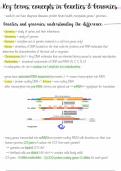
Lecture notes from Imperial College London, Medical Biosciences BSc, 2nd year, genetics and genomics (GEN) module. What are Genetics and Genomics and why are they so important? As more and more was learned about genes, and the chromosomes that carry them, the importance of genomes emerged. Genomics allows us to study how all this genetic material works together to underpin complex characteristics. These days the news is full of good and bad stories about the influence of Genetics and Genomics...
- Package deal
- Notes de cours
- • 5 pages's •
-
Imperial College London•Genetics
-
Genetics & Genomics module Imperial College London• Parlisaribau
Aperçu 2 sur 5 pages
Lecture notes from Imperial College London, Medical Biosciences BSc, 2nd year, genetics and genomics (GEN) module. What are Genetics and Genomics and why are they so important? As more and more was learned about genes, and the chromosomes that carry them, the importance of genomes emerged. Genomics allows us to study how all this genetic material works together to underpin complex characteristics. These days the news is full of good and bad stories about the influence of Genetics and Genomics...
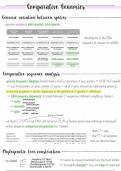
Lecture notes from Imperial College London, Medical Biosciences BSc, 2nd year, genetics and genomics (GEN) module. By comparing the sequences of different species we can identify sequences that have been conserved over long periods of evolution and so are likely to have important biological functions. You will also see how the extent of such sequence conservation can be used to measure evolutionary relationships between the species. Similarly, when comparing sequences repeats within a single ...
- Package deal
- Notes de cours
- • 3 pages's •
-
Imperial College London•Genetics
-
Genetics & Genomics module Imperial College London• Parlisaribau
Aperçu 1 sur 3 pages
Lecture notes from Imperial College London, Medical Biosciences BSc, 2nd year, genetics and genomics (GEN) module. By comparing the sequences of different species we can identify sequences that have been conserved over long periods of evolution and so are likely to have important biological functions. You will also see how the extent of such sequence conservation can be used to measure evolutionary relationships between the species. Similarly, when comparing sequences repeats within a single ...
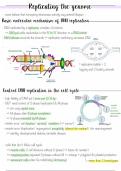
Lecture notes from Imperial College London, Medical Biosciences BSc, 2nd year, genetics and genomics (GEN) module. Focus on replication of the genome. Before a cell divides, the entire genome of 3 billion base pairs must first be copied: accurately, quickly and just once per cell cycle. During this replication, chromosomal DNA must be unwound without getting tangled or suffering breakages and, if damage occurs, it must be repaired. Failure to meet any of these requirements may result in damag...
- Package deal
- Notes de cours
- • 7 pages's •
-
Imperial College London•Genetics
-
Genetics & Genomics module Imperial College London• Parlisaribau
Aperçu 2 sur 7 pages
Lecture notes from Imperial College London, Medical Biosciences BSc, 2nd year, genetics and genomics (GEN) module. Focus on replication of the genome. Before a cell divides, the entire genome of 3 billion base pairs must first be copied: accurately, quickly and just once per cell cycle. During this replication, chromosomal DNA must be unwound without getting tangled or suffering breakages and, if damage occurs, it must be repaired. Failure to meet any of these requirements may result in damag...
